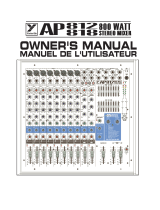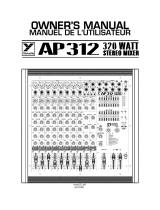
AM55/AM85/AM105/AM105FX/AM125/AM125FX
English
3
1
2
10
4
7
6
3
8
9
5
AM85
MAKING CONNECTIONS
Inputs and Outputs
1. XLR Microphone Jacks
These jacks accept typical
3-pin XLR inputs for balanced
and unbalanced signals. They
can be used in conjunction
with microphones – such as
professional condenser, dynamic
or ribbon microphones – with
standard XLR male connectors,
and feature low noise preamplifiers, serving for
crystal clear sound replication. With exception to
the AM55, each of the AM series mixers features
two standard XLR microphone inputs for your
convenience.
NB. When these inputs are used with condenser
microphones, the Phantom Power should be activated.
However, when Phantom Power button is engaged, single
ended (unbalanced) microphones and instruments should not
be used on the Mic inputs unless specically approved by the
microphone manufacturer.
2. Line Inputs
This input accepts typical 1/4” TRS or TS inputs for
balanced or unbalanced signals. There are various
numbers of these inputs depending which mixer
you are using. They can be used in conjunction with
various line level devices, such as keyboards, drum
machines, electric guitars, and a variety of other
electric instruments.
3. Stereo Channels
Each of the AM Mixers feature a few stereo channels,
thrown in for maximum flexibility. Each of these
stereo channels features two 1/4” phone jacks, for
the addition of various line level input devices, such
as electronic keyboards, guitars and external signal
processors or mixers. These stereo channels can
also be used as mono channels, where the signal
from any 1/4” phone jack plugged into the left stereo
input will cause the signal to duplicate to the right
input also. This does not work in reverse, however.
4. Main L and R Output
These two ports will output the nal stereo line level
signal sent from the main mixing bus. The primary
purpose of these jacks is to send the main output to
external devices, which may include power ampliers
(and in-turn, a pair of speakers), other mixers, as well
as a wide range of other possible signal processors
(equalizers, crossovers, etcetera).
5. Stereo AUX Return (AM85 only)
These 1/4” TS inputs are for the
return of audio to the AM85 mixer,
processed by an external signal
processor. If really needed, they can
also be used as additional inputs, with
a level control located on the face of
the mixer. The Stereo AUX Return can also accept
mono signals. Like with the stereo input channels,
these inputs can be used as mono channels by
plugging the 1/4” phone plug of any mono device into
the Stereo AUX return’s left input.
6. AUX/EFX Send (AM85, AM105, AM105FX,
AM125 and AM125FX only)
These 1/4” TS outputs may be used to connect to
an external digital effect processor, or even to an
amplier and speakers (depending on your desired
settings) to the mixer. The signal is taken from the
AUX control on each input channel. On the AM105FX
and AM125FX, the signal sent from this output is
taken from the built-in effect engine. This output
is only featured on the AM85, AM105, AM105FX,
AM125 and AM125FX mixers; therefore you shouldn’
t go looking for it on the AM55.
7. Phones
This stereo output port is suited for use with
headphones, allowing monitoring of the mix. The
audio level of this output is controlled using the
Phones or Phones/Control Room control.
8. 2T Record / Record Out
These outputs will accommodate
RCA cables, able to be fed to a
variety of recording devices.
9. 2T Return
These RCA inputs are used to connect the mixer
with parallel external devices, such as sub mixers or
external effect processors, receiving the processed
signal from another source and feeding it to either
the Main L and R or the Phones mixing bus.
10. Control Room Outputs (AM85, AM105,
AM105FX, AM125 and AM125FX only)
These two 1/4” phone jack outputs feed the signal
altered by the Control Room/Phones level control
on the face of the mixer. This output has extensive
use, as it can be used to feed the signal from the
mixer to an active monitor, for the monitoring of the
audio signal from within a booth, or, alternatively, for
the addition of external signal processing devices
or mixers, as well as acting as a “side fill” output,
supplying audio to indoor areas that the main
speakers do not reach. This output is featured on
the AM85, AM105, AM105FX, AM125 and AM125FX
mixers only.






















